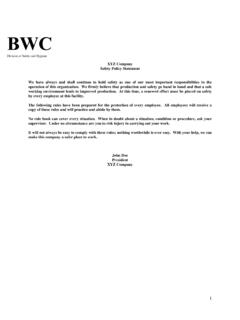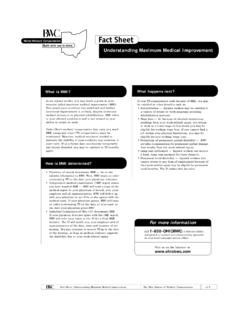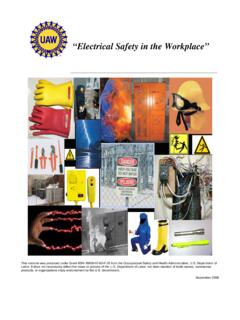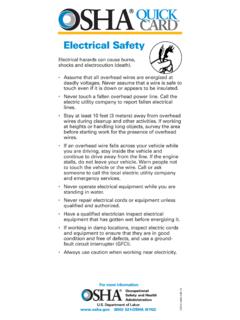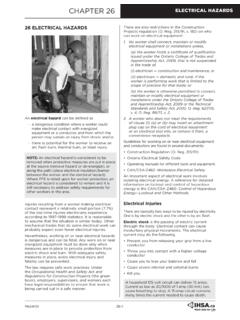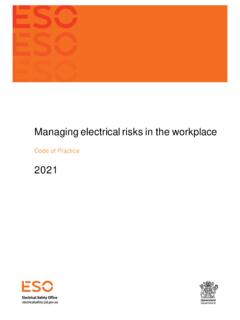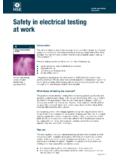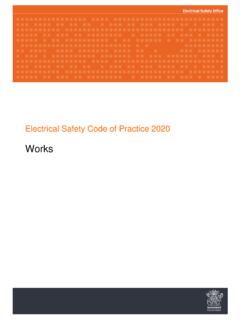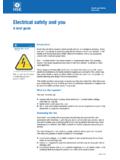Transcription of SAMPLE WRITTEN PROGRAM ELECTRICAL SAFETY - Ohio
1 BWCD ivision of SAFETY and HygieneSAMPLE WRITTEN PROGRAMELECTRICAL SAFETYPURPOSEE lectricity is a serious work place hazard, capable of causing both employee injury (shocks, electrocution,fires and explosions) as well as serious property damage. By providing maintenance personnel with propertraining in safe ELECTRICAL work practices, (Company name) hopes to reduce the risk of such (Company name) management is responsible for providing employee SAFETY training, conducting electricalsafety inspections, correcting all ELECTRICAL SAFETY hazards, and ensuring that all new ELECTRICAL equipmentand components comply with codes and are responsible for the immediate reporting of ELECTRICAL SAFETY hazards, for not working onelectrical equipment without proper training and authorization, and for inspecting equipment prior to worker: An employee who is trained and authorized to perform work on ELECTRICAL equipmentand worker.
2 An employee who has not been trained or authorized to perform ELECTRICAL CONTROLThe following control methods will be used to prevent occurrence of electricity-related incidents:Engineering Controls All ELECTRICAL distribution panels, breakers, disconnects, switches and junction boxes must becompletely enclosed; Water-tight enclosures must be used if any of these components could possibly be exposed tomoisture; Structural barriers must be used to prevent accidental damage to ELECTRICAL components; Conduits must be supported for their entire length, and non- ELECTRICAL attachments to conduits areprohibited; Non-rigid ELECTRICAL cords must have strain relief wherever Controls Only trained, authorized employees may repair or service ELECTRICAL equipment; Contractors must be licensed to perform ELECTRICAL work; Physical barriers must be used to prevent unauthorized persons from entering areas where newinstallation or repair of ELECTRICAL components or equipment is being performed; Only authorized employees may enter ELECTRICAL distribution rooms; All ELECTRICAL control devices must be labeled properly; Senior facility management must authorize any work on energized ELECTRICAL Practice Controls Employees covered under this policy must wear electrically rated SAFETY shoes or boots; Use only tools that are properly insulated.
3 Non-conductive gloves will be available for work on ELECTRICAL equipment; ELECTRICAL -rated matting will be placed in front of all electricity-distribution EQUIPMENT INSPECTIONSI nspect all ELECTRICAL equipment for hazards that could cause employee injury or death. Consider thefollowing factors when determining the SAFETY of the equipment: Suitability for the intended use; Proper insulation; Heating effects under conditions of use; Arcing effects; Classification by type, size, voltage, current capacity and intended PROTECTIVE EQUIPMENT(Company name) will provide personal protective equipment for use by employees working in areas wherethey could be exposed to ELECTRICAL are required to observe the following procedures for PPE use: PPE use is mandatory when contact with exposed ELECTRICAL sources is likely; Only use PPE that is designed for the work being performed; Inspect and test all PPE prior to use.
4 Use a protective outer cover (leather, for example) if the work being performed might damage thePPE s insulation; Wear non-conductive headgear if there is danger of ELECTRICAL burns or shock from contact withexposed, energized equipment; Wear eye and/or face protection any time there is danger of flying objects, flashes or ELECTRICAL arcsproduced by an ELECTRICAL TRAININGQ ualified EmployeesTraining for those employees qualified to perform ELECTRICAL work will consist of: Specific equipment procedures; The training requirements outlined in OSHA standard 29 CFR to EmployeesEmployees not qualified or authorized to perform work on ELECTRICAL equipment and components will betrained in general ELECTRICAL SAFETY precautions for the purpose of hazard following ELECTRICAL SAFETY rules also apply to unqualified employees: Do not conduct any ELECTRICAL repairs; Report all ELECTRICAL hazards to your supervisor; Do not operate equipment if you believe there is an ELECTRICAL hazard; Do not allow ELECTRICAL equipment or components to contact water; Remember that even low-voltage electricity can be physically harmful; Do not use cords or plugs that are missing the ground prong; Do not overload ELECTRICAL receptacles.
